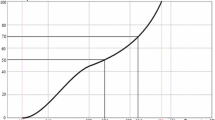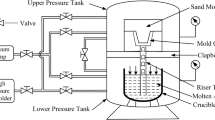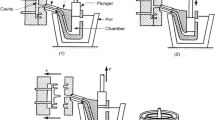Abstract
Many practical high-pressure die casting process (HPDCP) optimization problems are multi-objective optimization ones that optimize multiple quality attributes of castings, simultaneously. This paper proposed a new HPDCP optimization method for improving volume of shrinkage porosity (VSP) and air entrainment (AE) using Taguchi-based ProCAST simulation and multi-attribute decision-making (MADM)-based overall quality index. Taguchi orthogonal array was used to design ProCAST simulation experiment. MADM was used to convert multiple quality attributes into a single overall quality index (OQI). Taguchi optimization method was used to determine the optimal HPDCP parameters to maximize the OQI. By using the proposed method, this paper determined the optimal HPDCP parameters such as pouring temperature (PT), filling rate in shot sleeve (FR), piston velocity (PV) and preheating mold temperature (PMT) for improving the VSP and AE in carburetor housing with aluminum alloy AlSi9Cu1Mg. The optimal HPDCP parameters were PT of 640 °C, FR of 40%, PV of 6.5 m/s, and PMT of 150 °C. The PT was the most effective HPDCP parameter for improving the VSP and AE, and the next were FR, PV, and PMT. The proposed method could be actively applied to not only HPDCP but also other casting processes and other manufacturing processes.









Similar content being viewed by others
Data availability
The authors confirm that the data supporting the findings of this study are available within this article.
Code availability
The code that supports the findings of this study is available from the corresponding author (Won-Chol Yang), upon a reasonable request.
References
Dou K, Lordan E, Zhang YJ, Jacot A, Fan ZY (2021) A novel approach to optimize mechanical properties for aluminum alloy in high pressure die casting (HPDC) process combining experiment and modelling. J Mater Process Tech 296:117193
Hsu QC, Do AT (2013) Minimum porosity formation in pressure die casting by Taguchi method. Mathematical Problems in Engineering 2013:Article ID 920865:1–9
Tsoukalas VD (2008) Optimization of porosity formation in AlSi9Cu3 pressure die castings using genetic algorithm analysis. Mater Des 29:2027–2033
Brown JR (1999) Foseco Non-ferrous Foundryman’s Handbook. In: Brown, J.R. (Ed.). Butterworth-Heinemann, Oxford
Neto B, Kroeze C, Hordijk L, Costa C (2008) Modelling the environmental impact of an aluminum pressure die casting plant and options for control. Environ Model Softw 23:147–168
Syrcos GP (2003) Die casting process optimization using Taguchi methods. J Mater Process Technol 135:68–74
Hu MY, Cai JJ, Sun WL et al (2016) DIE CASTING SIMULATION AND PROCESS OPTIMIZATION OF AN A356 ALUMINUM ALLOY POLISHING PLATE. Int J Metalcast 10(3):315–321
Verran GO, Mendes RPK, Valentina LVOD (2008) DOE applied to optimization of aluminum alloy die castings. J Mater Process Technol 2008:120–125
Kittur JK, Choudhari MN, Parappagoudar MB (2015) Modeling and multi-response optimization of pressure die casting process using response surface methodology. Intl J Adv Manuf Technol 77:211–224
Mohiuddin MVK, A, Hussainy SF, Laxminarayana P, (2016) Influence of process parameters on quality of Al7SiMg alloy casting using statistical techniques. Mater Today: Proceedings 3:3726–3733
Apparao KC, Birru AK (2017) QFD-Taguchi based hybrid approach in die casting process optimization. Trans Nonferrous Met Soc China 27:2345–2356
Murugarajan A, Raghunayagan P (2019) The impact of pressure die casting process parameters on mechanical properties and its defects of A413 aluminum alloy. Metalurgija 58(1–2):55–58
Dou K, Lordan E, Zhang YJ, Jacot A, Fan ZY (2020) A complete computer aided engineering (CAE) modelling and optimization of high pressure die casting (HPDC) process. Journal of Manufacturing Processe; https://doi.org/10.1016/j.jmapro.2020.10.062
Yan H, Zhuang W, Yong Hu et al (2007) Numerical simulation of AZ91D alloy automobile plug in pressure die casting process. J Mater Process Technol 187–188:349–353
Sharifi P, Jamali J, Sadayappan K, Wood JT (2018) Quantitative experimental study of defects induced by process parameters in the high-pressure die cast process. Metallurgical and Materials Transactions A.49A:3080–3090
Boydak O, Savas M, Ekici B (2016) A numerical and an experimental investigation of a high-pressure die-casting aluminum alloy. Int J Metalcast 10(1):56–69
Fiorese E, Richiedei D, Bonollo F (2017) Analytical computation and experimental assessment of the effect of the plunger speed on tensile properties in high-pressure die casting. Int J Adv Manuf Technol 91:463–476
Armillotta A, Fasoli S, Guarinoni A (2016) Cold flow defects in zinc die casting: prevention criteria using simulation and experimental investigations. Int J Adv Manuf Technol 85:605–622
Korti AIN, Abboudi S (2017) Effects of shot sleeve filling on evolution of the free surface and solidification in the high-pressure die casting machine. Int J Metalcast 11(2):223–239
Hu MY, Cai JJ, Li N et al (2018) Flow modeling in high-pressure die-casting processes using sph model. Int J Metalcast 12(1):97–105
Jiang WM, Fan ZT, Liu DJ, Dong XP, Wu HB, Wang HS (2013) Effects of process parameters on internal quality of castings during novel casting. Mater Manuf Processes 28(1):48–55
Jiang WM, Fan ZT, Liu DJ, Wu HB (2013) Influence of gas flowrate on filling ability and internal quality of A356 aluminum alloy castings fabricated using the expendable pattern shell casting with vacuum and low pressure. Int J Adv Manuf Technol 67(9–12):2459–2468
Yang JY, Yang WC, Kim RC, Chadha U (2023) Development of overall quality index and overall quality map according to tensile mechanical properties and artificial aging heat treatment conditions for cast aluminum alloy using multi-criteria decision-making and multiple regression model, International Journal on Interactive Design and Manufacturing (IJIDeM); https://doi.org/10.1007/s12008-023-01367-9
Yang WC, Yang JY, Kim RC, Om MS, Kim UH, Ri WS, Sok SH (2023) Multi-attribute optimization and influence assessment methodology of casting process parameters combined with integrated MADM and Taguchi method, The International Journal of Advanced Manufacturing Technology; https://doi.org/10.1007/s00170-023-12275-3
Yang WC, Kang HS, Ri GS, Kim JS (2022) Consistency improvement method of pairwise matrix based on consistency ratio decreasing rate and attribute weighting method considered decision makers’ levels in analytic hierarchy process: application to hip joint prosthesis material selection. Mathematical Problems in Engineering 2022: Article ID 1463006:1–22
Yang WC, Choe CM, Kim JS, Om MS, Kim UH (2021) Materials selection method using improved TOPSIS without rank reversal based on linear max-min normalization with absolute maximum and minimum values. Materials Research Express 9: Article ID 065503:1–16
Yang WC, Ri W, Yang JY (2022) Choe CM (2022) A new material selection method based on weighted mean values of overall performance scores from different multicriteria decision-making methods, Advances in Materials Science and Engineering. Article ID 4479803:1–9
Acknowledgements
This work was supported by Kim Chaek University of Technology, Democratic People’s Republic of Korea. The supports are gratefully acknowledged.
Author information
Authors and Affiliations
Contributions
Ryong-Chol Kim designed the research work, conducted ProCAST simulation experiment for this work, analyzed the result, and wrote the paper. Ji-Yon Yang developed the MATLAB code for determining the optimal HPDCP parameters and wrote the paper. Kyong-Ryul Hong designed the simulation experiment and discussed the result. Won-Chol Yang developed the MATLAB code for calculating the OQIs using MADMs and wrote the paper.
Corresponding author
Ethics declarations
Ethics approval
The authors approve to observe the ethics standard of this journal.
Conflict of interest
The authors declare no competing interests.
Open access
There is no open access.
Additional information
Publisher's Note
Springer Nature remains neutral with regard to jurisdictional claims in published maps and institutional affiliations.
Rights and permissions
Springer Nature or its licensor (e.g. a society or other partner) holds exclusive rights to this article under a publishing agreement with the author(s) or other rightsholder(s); author self-archiving of the accepted manuscript version of this article is solely governed by the terms of such publishing agreement and applicable law.
About this article
Cite this article
Kim, RC., Hong, KR., Yang, JY. et al. High-pressure die casting process optimization for improving shrinkage porosity and air entrainment in carburetor housing with aluminum alloy using Taguchi-based ProCAST simulation and MADM-based overall quality index. Int J Adv Manuf Technol 132, 893–906 (2024). https://doi.org/10.1007/s00170-024-13428-8
Received:
Accepted:
Published:
Issue Date:
DOI: https://doi.org/10.1007/s00170-024-13428-8




